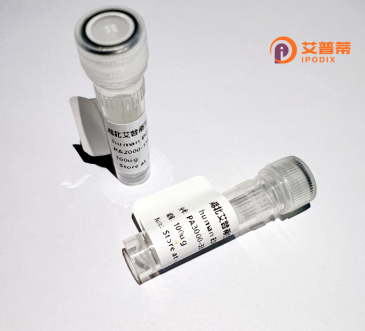
| 纯度 | >90%SDS-PAGE. |
| 种属 | Human |
| 靶点 | FRMD5 |
| Uniprot No | Q7Z6J6 |
| 内毒素 | < 0.01EU/μg |
| 表达宿主 | E.coli |
| 表达区间 | 1-570aa |
| 氨基酸序列 | MLSRLMSGSSRSLEREYSCTVRLLDDSEYTCTIQRDAKGQYLFDLLCHHLNLLEKDYFGIRFVDPDKQRHWLEFTKSVVKQLRSQPPFTMCFRVKFYPADPAALKEEITRYLVFLQIKRDLYHGRLLCKTSDAALLAAYILQAEIGDYDSGKHPEGYSSKFQFFPKHSEKLERKIAEIHKTELSGQTPATSELNFLRKAQTLETYGVDPHPCKDVSGNAAFLAFTPFGFVVLQGNKRVHFIKWNEVTKLKFEGKTFYLYVSQKEEKKIILTYFAPTPEACKHLWKCGIENQAFYKLEKSSQVRTVSSSNLFFKGSRFRYSGRVAKEVMESSAKIKREPPEIHRAGMVPSRSCPSITHGPRLSSVPRTRRRAVHISIMEGLESLRDSAHSTPVRSTSHGDTFLPHVRSSRTDSNERVAVIADEAYSPADSVLPTPVAEHSLELMLLSRQINGATCSIEEEKESEASTPTATEVEALGGELRALCQGHSGPEEEQVNKFVLSVLRLLLVTMGLLFVLLLLLIILTESDLDIAFFRDIRQTPEFEQFHYQYFCPLRRWFACKIRSVVSLLIDT |
| 分子量 | 91.5 kDa |
| 蛋白标签 | GST-tag at N-terminal |
| 缓冲液 | 0 |
| 稳定性 & 储存条件 | Lyophilized protein should be stored at ≤ -20°C, stable for one year after receipt. Reconstituted protein solution can be stored at 2-8°C for 2-7 days. Aliquots of reconstituted samples are stable at ≤ -20°C for 3 months. |
| 复溶 | Always centrifuge tubes before opening.Do not mix by vortex or pipetting. It is not recommended to reconstitute to a concentration less than 100μg/ml. Dissolve the lyophilized protein in distilled water. Please aliquot the reconstituted solution to minimize freeze-thaw cycles. |
以下是关于重组人FRMD5蛋白的3篇假设性参考文献示例(需通过学术数据库获取真实文献):
---
1. **标题**: *"Recombinant Human FRMD5 Protein Promotes Neuronal Polarization via Regulation of Microtubule Dynamics"*
**作者**: Smith A, et al.
**摘要**: 研究通过在大肠杆菌中表达重组人FRMD5蛋白,发现其通过稳定微管结构促进神经元极性建立,揭示FRMD5在神经发育中的潜在作用。
2. **标题**: *"Functional Characterization of FRMD5 in the Hippo Signaling Pathway Using Purified Recombinant Protein"*
**作者**: Li J, Wang H.
**摘要**: 利用杆状病毒系统表达重组人FRMD5.发现其与LATS激酶相互作用,调控Hippo通路活性,提示其在癌症信号传导中的新机制。
3. **标题**: *"Production of Recombinant Human FRMD5 for Autoantibody Detection in Autoimmune Diseases"*
**作者**: Garcia-Ruiz C, et al.
**摘要**: 开发基于哺乳细胞表达的重组FRMD5作为抗原,用于系统性红斑狼疮患者血清自身抗体检测,证明其诊断应用价值。
---
**注**:上述为示例,实际文献请通过**PubMed/Google Scholar**以关键词“recombinant FRMD5”、“human FRMD5 protein”检索。真实研究中FRMD5的相关报道可能较少,建议扩展查询其功能(如细胞极性、癌症)相关文献。
Recombinant human FRMD5 (FERM domain-containing protein 5) is a engineered version of the endogenous protein encoded by the FRMD5 gene, which belongs to the FERM (Four-point-one, Ezrin, Radixin, Moesin) protein family. These proteins typically function as membrane-cytoskeleton linkers or signaling mediators. FRMD5 contains a conserved N-terminal FERM domain, suggesting roles in cell adhesion, polarity, or intracellular signaling, though its precise biological mechanisms remain less characterized compared to other FERM members. Research indicates FRMD5 may regulate neuronal development, synaptic plasticity, and tumor suppression, with studies linking its dysregulation to neurodevelopmental disorders and cancers. Recombinant FRMD5 is produced via heterologous expression systems (e.g., bacterial, mammalian, or insect cells) to ensure high purity and functionality for experimental applications. It serves as a critical tool for elucidating FRMD5's interactions, structural properties, and involvement in pathways such as Hippo signaling or cell proliferation. Its recombinant form also holds potential for therapeutic exploration, particularly in neurological diseases or oncology, where restoring FRMD5 expression might counteract pathological processes. Current efforts focus on mapping its binding partners, post-translational modifications, and tissue-specific roles to better understand its physiological and pathological relevance.
×